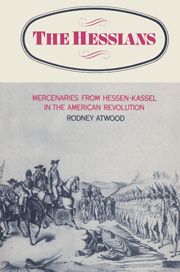Book contents
- Frontmatter
- Contents
- List of maps
- Acknowledgements
- Abbreviations
- Note on German ranks and currency
- Introduction
- 1 The German soldier trade
- 2 The Hessians go to America
- 3 The victories of 1776
- 4 The Battle of Trenton
- 5 The campaigns of 1777–81
- 6 Anglo-Hessian relations
- 7 The Hessian view of the American Revolution
- 8 Hessian plundering
- 9 Hessian desertion
- 10 Recruiting in Germany
- 11 The impact of the war on Hessen
- 12 Conclusion
- Appendices
- Bibliography
- Index
5 - The campaigns of 1777–81
Published online by Cambridge University Press: 04 August 2010
- Frontmatter
- Contents
- List of maps
- Acknowledgements
- Abbreviations
- Note on German ranks and currency
- Introduction
- 1 The German soldier trade
- 2 The Hessians go to America
- 3 The victories of 1776
- 4 The Battle of Trenton
- 5 The campaigns of 1777–81
- 6 Anglo-Hessian relations
- 7 The Hessian view of the American Revolution
- 8 Hessian plundering
- 9 Hessian desertion
- 10 Recruiting in Germany
- 11 The impact of the war on Hessen
- 12 Conclusion
- Appendices
- Bibliography
- Index
Summary
THE ATTACK ON REDBANK
The reputation of the Hessian grenadiers is too well known to want an eulogium from my pen. In all times, in all places, in every situation, their conduct and valour have distinguished them.
After his unsuccessful thrusts in New Jersey, Howe, intent upon the rebel capital Philadelphia, embarked the best of his troops at Staten Island in the first half of July 1777, and sailed on the 23rd, landing after a protracted voyage at the head of Chesapeake Bay a month later. The embarkation returns of the expedition show Howe's reduced dependence on the mercenaries: of 16, 498 troops only 4, 441 were Hessians. Clinton was left to hold New York and its outposts with Provincials, the bulk of the Germans, and some British.
During Howe's campaign the Jäger, particularly Captains Ewald and Wreden, distinguished themselves on numerous occasions and defeated ‘Scotch Willy’ Maxwell's corps at Iron Hill. Throughout the campaign a Jäger piquet of three officers and seventy men marched at the head of the army. But in the two major battles, Brandywine and Germantown, the British did the lion's share of the fighting. Hessian casualties were trifling in each: 6 killed and 24 wounded at Brandywine, 14 wounded at Germantown. One British officer went so far as to write of Brandywine, that the Hessians ‘had not the least share in this victory – having fired neither gun nor musket shot the whole day’.
- Type
- Chapter
- Information
- The Hessians , pp. 117 - 143Publisher: Cambridge University PressPrint publication year: 1980

